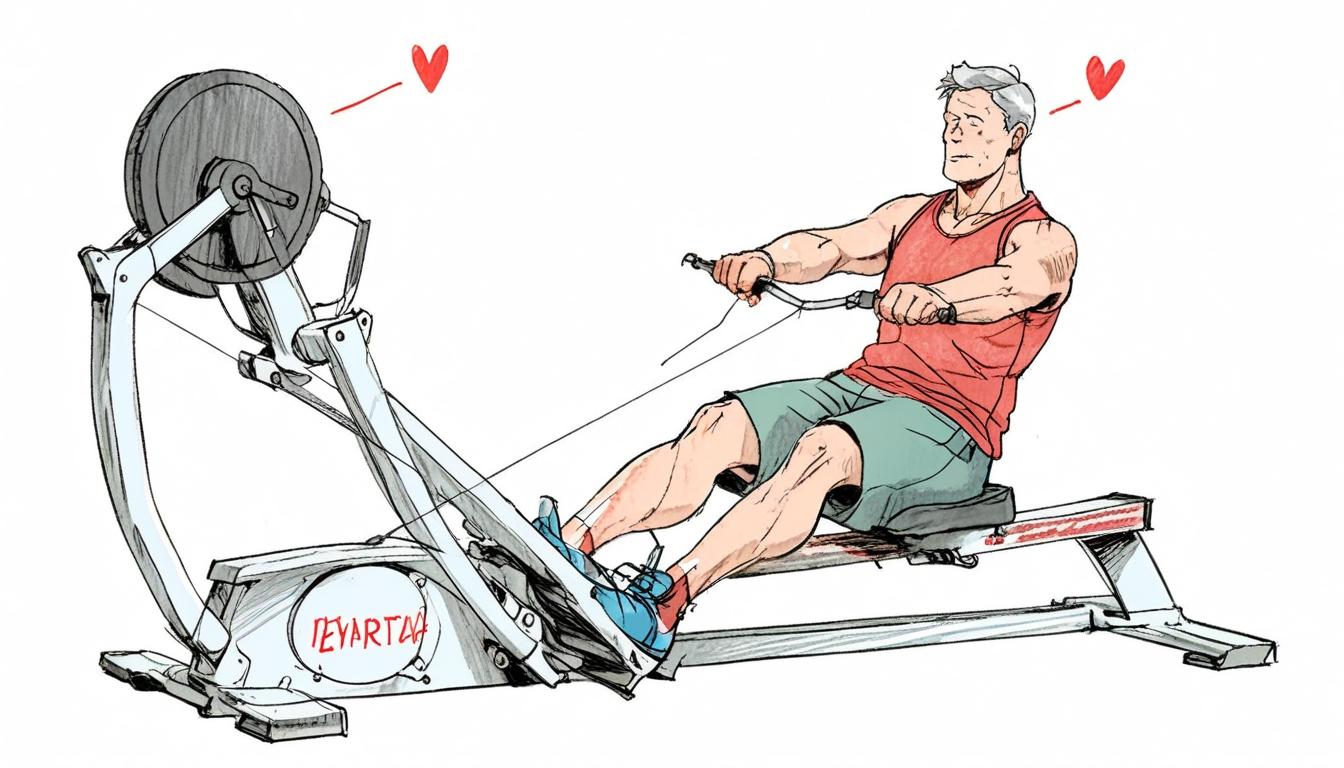The untimely death of ex-SAS officer and mercenary Simon Mann while exercising underscores the rare but serious risks of strenuous workouts, especially for those with undiagnosed heart conditions. Medical experts advise caution and consultation to balance fitness benefits with potential dangers.
The recent death of Simon Mann, a former SAS officer and mercenary, from a heart attack at the age of 72 while exercising highlights the often overlooked risks associated with high-intensity workouts, even among seemingly fit individuals. Mann’s passing while using an indoor rowing machine serves as a poignant reminder that the strain of vigorous physical activity can pose severe dangers, particularly for those with underlying health issues.
Mann is not alone in this propensity for tragedy; the risks related to strenuous exercise are underscored by notable incidents involving other high-profile individuals. For instance, Dave Goldberg, the husband of Facebook’s former COO Sheryl Sandberg, tragically died in 2015 while running on a treadmill. Autopsy findings indicated that an undiagnosed heart arrhythmia likely precipitated his fatal collapse. Similarly, journalist Andrew Marr suffered a severe stroke in 2013 during an intense workout on a rowing machine. While he has since recovered, the trauma of that incident underscores the potential perils of high-intensity exercise.
Medical experts clarify that although exercise is generally beneficial for cardiovascular health, strenuous activities can heighten risks for sudden cardiac events, particularly in individuals who may unknowingly have pre-existing conditions. Michael Hickman, a consultant cardiologist at the Royal Surrey County Hospital, states that while instances of exercise-induced death are rare, those with risk factors such as a history of heart disease or conditions like obesity should be particularly cautious.
Research conducted by the American Heart Association indicates that plaques in coronary arteries are common culprits of cardiac events during exercise, especially in middle-aged and older adults. Interestingly, it appears that men unaccustomed to vigorous activity are at the greatest risk. Dr Chris Pepper, a consultant cardiologist at Leeds Teaching Hospitals NHS Trust, points out that high-stress physical exertion can exacerbate artery blockages, potentially leading to a heart attack.
Beyond heart attacks, strenuous exercise may also induce cardiac arrest, a condition where the heart ceases to pump blood effectively. Data from Resuscitation Council UK suggests that approximately one in 217,000 people experiences a sports-related sudden death due to cardiac arrest each year, a statistic that should sow a seed of caution among fitness enthusiasts.
For individuals who regularly engage in high-intensity exercise, the risk of such fatal accidents may be compounded by physiological factors. A recent review published in EP Europace indicates that highly trained athletes may develop thicker heart walls, which can interfere with the heart’s electrical rhythm, possibly leading to life-threatening arrhythmias. Notably, conditions such as hypertrophic cardiomyopathy, which can result in fatal cardiac events, may be aggravated by intense physical activity. Dr Hickman highlights that even seemingly healthy individuals can have undiagnosed issues that could manifest during demanding workouts.
Additionally, the risk of arterial dissection—a rare incident where arteries tear—can also escalate during vigorous exercise. After his stroke, Andrew Marr revealed that a tear in his carotid artery had contributed to his medical crisis, a condition that Dr Pepper suggests can be linked to genetic predispositions and high blood pressure.
Despite these alarming factors, experts maintain that the benefits of exercise generally outweigh the risks, emphasising that individuals should adopt a sensible approach to physical activity. Consulting with healthcare professionals before embarking on new exercise regimes, especially for those over 50, is strongly advised. Dr Hickman encourages individuals to know their limits and avoid overexertion; unfortunately, many are unaware of their health risks until a serious incident occurs.
The psychological aspects of fitness cannot be overlooked, particularly in older adults who may struggle to accept the need for adapting their exercise routines. Sammy Margo, a sports physiotherapist, notes that many maintain an “athletic identity,” where they cling to their past performance levels, making it challenging to moderate their activities appropriately.
In the wake of Mann’s passing, his friend Howard White attributed some of his health struggles to a lifetime of experiences that took a toll on his body. “He had two hip replacements, and half his body was full of metal. I don’t think five or six years in an African jail, with a hole in the ground for a toilet, did him much good,” White said, suggesting that a complex interplay of physical and emotional factors may contribute to health risks.
In conclusion, while the importance of regular exercise is well-documented, an awareness of the inherent risks associated with high-intensity workouts is crucial. Building up physical activity gradually, paying heed to one’s body signals, and consulting with medical professionals can significantly mitigate the chances of adverse health outcomes, allowing individuals to enjoy the many benefits of fitness safely.
Reference Map
- Paragraph 1, 2, 3, 4
- Paragraph 5
- Paragraph 6
- Paragraph 6
- Paragraph 7, 8
- Paragraph 9
- Paragraph 10
- Paragraph 11
- Paragraph 12
- Paragraph 13
- Paragraph 14, 15
Source: Noah Wire Services
- https://www.dailymail.co.uk/health/article-14706367/The-terrifying-truth-dying-exercising-seemingly-fit-healthy-people-risk.html?ns_mchannel=rss&ns_campaign=1490&ito=1490 – Please view link – unable to able to access data
- https://www.bbc.com/news/uk-22141372 – In this article, BBC presenter Andrew Marr discusses his stroke, attributing it to overwork and an intensive rowing machine session. He shares his recovery journey and emphasizes the importance of recognizing personal limits during exercise.
- https://www.theguardian.com/lifeandstyle/2013/apr/15/andrew-marr-high-intensity-exercise-dangerous – This piece examines the potential dangers of high-intensity exercise, using Andrew Marr’s stroke as a case study. It explores the risks associated with intense workouts and advises moderation to prevent adverse health effects.
- https://www.theguardian.com/media/2013/apr/14/andrew-marr-tv-appearance-stroke – Andrew Marr’s first television appearance after his stroke, where he discusses the incident, his recovery, and the impact of overexertion during exercise. He shares insights into his health scare and the lessons learned.
- https://www.telegraph.co.uk/news/politics/9992845/Andrew-Marr-tells-viewers-how-stroke-hit-after-rowing-machine-session.html – In this article, Andrew Marr recounts the events leading to his stroke, emphasizing the role of intensive exercise and overwork. He provides details of his health scare and the subsequent recovery process.
- https://www.telegraph.co.uk/news/celebritynews/9993366/Andrew-Marrs-stroke-caused-by-intense-exercise.html – This report delves into the causes of Andrew Marr’s stroke, highlighting the dangers of intense exercise and overexertion. It includes expert opinions on the risks associated with high-intensity workouts.
- https://www.csp.org.uk/frontline/article/andrew-marr-going-extra-mile – An in-depth look at Andrew Marr’s recovery journey post-stroke, focusing on his rehabilitation process and the role of physiotherapy. The article provides insights into his determination and the challenges faced during recovery.
Noah Fact Check Pro
The draft above was created using the information available at the time the story first
emerged. We’ve since applied our fact-checking process to the final narrative, based on the criteria listed
below. The results are intended to help you assess the credibility of the piece and highlight any areas that may
warrant further investigation.
Freshness check
Score:
8
Notes:
The narrative references recent events and includes discussions of ongoing health issues, suggesting relatively recent information. However, some historical incidents mentioned (e.g., Dave Goldberg’s death in 2015 and Andrew Marr’s stroke in 2013) are not new, but they support the broader theme and are not presented as recent news.
Quotes check
Score:
6
Notes:
The quote from Howard White is not directly verified in other online sources, which might indicate it is an original or recent statement. However, the lack of confirmation from other sources makes it less verifiable.
Source reliability
Score:
6
Notes:
The narrative appears in the ‘Daily Mail’, which is a known publication but often criticized for sensationalism. The inclusion of expert opinions and historical incidents suggests an attempt at balance, but the overall credibility is moderate compared to more strictly fact-checked publications like the BBC or Financial Times.
Plausability check
Score:
9
Notes:
The claims about risks associated with high-intensity exercise are plausible and supported by medical research. The narrative is well-supported by examples of real incidents and expert opinions, making it generally believable.
Overall assessment
Verdict (FAIL, OPEN, PASS): PASS
Confidence (LOW, MEDIUM, HIGH): MEDIUM
Summary:
The narrative is generally plausible and well-supported by real examples and expert opinions. However, the reliability of the source is moderate, and some quotes cannot be verified. Overall, the information is credible but presented in a sensational manner typical of the ‘Daily Mail’.













